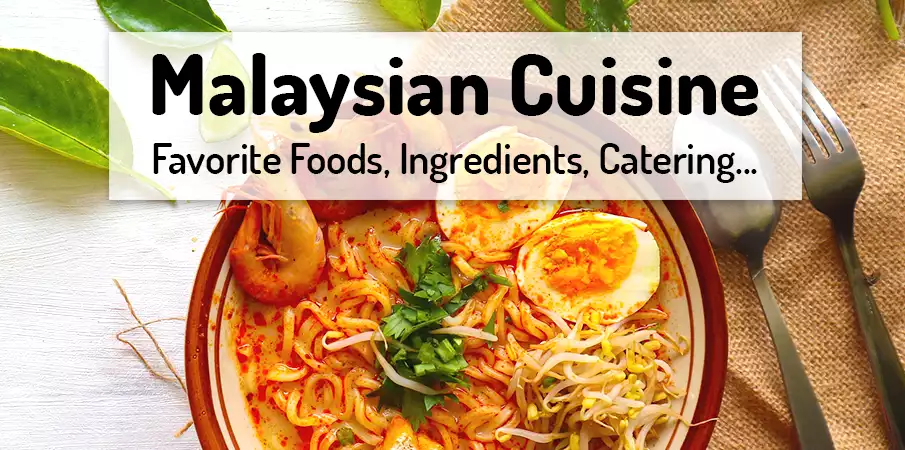
1. Cuisine in Malaysia
2. What to Expect
3. TOP Popular Dishes
4. Spices + Ingredients
5. Regional Variations
6. Food as an Event
7. Fruits + Vegetables
8. Beverages + Alcohol
9. Sweets and Desserts
10. Street Food
11. FAQs + Answers
Quick answer: Malaysian cuisine is a rich tapestry of Malay, Chinese, Indian, and indigenous flavours. It’s bold, colourful, and full of variety, whether you’re sampling satay on the street, feasting on banana leaf rice, or slurping laksa at a hawker stall.
At a glance:
- 🍜 Fusion Cuisine: A vibrant mix of Malay, Chinese, Indian, and native Bornean influences.
- 🍢 Street Food Favorites: Satay, roti canai, nasi lemak, and char kway teow.
- 🍲 Soups & Curries: Laksa, rendang, and coconut-based curries are staples.
- 🌶️ Spices & Herbs: Lemongrass, galangal, turmeric, pandan, and chilli.
- 🥥 Rice & Coconut: Rich coconut milk features in many dishes; rice is always present.
- 🌿 Fresh Ingredients: Tropical fruit, aromatic herbs, and seafood are common.
- 🥤 Local Beverages: Teh tarik, fresh coconut water, and fruit juices.
- 🍽️ Eating Style: Communal meals, night markets, and family-style dining.
Last updated in November 2025.
Malaysian Cuisine and Food – What To Know?
-
- Malaysia, a country rich in culture and diverse history, captivates not only with its exotic landscapes and stunning beaches but also with its varied and flavorful cuisine. Malaysian cuisine reflects a diverse blend of ethnic influences, intertwining Malay, Chinese, and Indian traditions, creating a unique gastronomic experience.
Aromatically and Exotically: The Taste Palette of Malaysian Delicacies.
-
- Foods in Malaysia are known for their distinct taste palette, richly spiced sauces, and dishes seasoned with aromatic flavors. Popular ingredients include coconut milk, lemongrass, coriander, and chili, giving the dishes an unforgettable character. This fusion of ingredients not only delights the senses but also showcases the intricacies and depth of Malaysian cuisine, making it a truly remarkable and globally appreciated culinary tradition.
Streets Full of Tempting Flavors: Malaysian Street Food.
-
- Malaysian cuisine is also renowned for its street food – known as street food, an integral part of the local culture. The streets of cities like Kuala Lumpur and George Town in Penang are filled with stalls offering a wide range of delicious treats. From inventive laksa noodles to kari mee, everyone will find something to suit their taste.
Nasi Lemak: King of National Cuisine.
-
- Nasi Lemak’s regal status in Malaysian cuisine is well-deserved, with its harmonious blend of fragrant coconut rice, succulent smoked chicken, crunchy peanuts, pickled cucumbers, and the spicy allure of chili sauce. Beyond being a delicious dish, Nasi Lemak is a cultural emblem, representing the fusion of diverse culinary influences that define Malaysia’s food landscape. Its popularity extends beyond borders, making it a must-try for anyone eager to explore the rich tapestry of flavors that characterizes this Southeast Asian culinary gem.
BOOK a TOUR / ACTIVITY in Malaysia ➜
What to Expect from Malaysian Cuisine as a Tourist:
When visiting Malaysia, tourists can anticipate an authentic culinary adventure in Southeast Asia, characterized by the unique flavors and aromas of this rich cuisine.
-
- Diversity of Tastes: Malaysian cuisine is renowned for its ability to combine diverse flavors and interesting ingredients into one dish. The fusion of sweet, salty, sour, and spicy creates unique taste compositions that will delight your taste buds.
- Aromatics and Exoticism: An integral part of Malaysian dishes is aromatic ingredients such as lemongrass, kaffir lime leaves, and galangal. These fragrances not only enrich the taste but also create unforgettable experiences for the sense of smell.
- Street Food Culture: Exploring the streets of cities unveils the fascinating world of Malaysian street food. Stalls offer a variety of delicacies, allowing tourists to savor authentic local cuisine in an informal and atmospheric setting.
- Utilization of Coconut: Coconut milk and coconut oil are essential components in Malaysian cuisine. These ingredients impart a creamy consistency and rich flavor to dishes, often contrasting with spicy or sweet elements.
- Diverse Dishes: Malaysian cuisine offers a wide range of dishes, including curries, noodles, rice-based meals, and various desserts. Each region has its own specialties, bringing a unique taste experience from every corner of the country.
- Spicy Culinary Adventures: For lovers of spicy sensations, Malaysian cuisine presents challenges. Local dishes may contain spicy elements, so it’s good to be prepared for adventurous taste experiments.
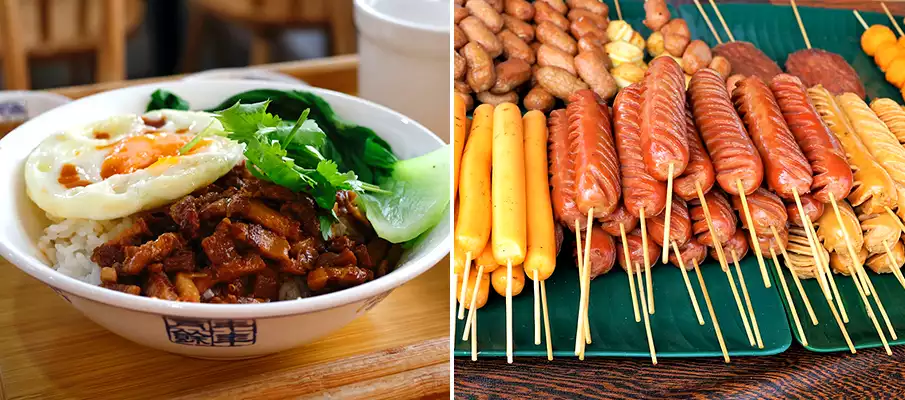
Popular Dishes and Top Delicacies in Malaysian Cuisine:
Malaysia, a country rich in cultural diversity, captivates visitors not only with its exotic landscapes but also with an irresistible palette of flavors in its cuisine. Malaysian gastronomy blends influences from Malay, Chinese, Indian, and ethnic traditions, creating unique and unforgettable dishes.
-
- 1. Nasi Lemak – King of Rice Dishes: Nasi Lemak, often considered a national dish, is rice cooked in coconut milk, served with smoked chicken, peanuts, pickled cucumbers, and spicy chili sauce. This dish symbolizes a harmony of flavors that are characteristic of Malaysian cuisine.
- 2. Laksa – Spicy Noodle Tribute: Laksa is a spicy noodle dish with a seasoned sauce that may include shrimp, chicken, or fish. Spices, coconut milk, and herbs create a unique flavor mix that varies from region to region.
- 3. Hainanese Chicken Rice – Hainanese Beef Rice: Derived from Chinese cuisine, this dish features boiled chicken or beef served with aromatic rice and soy-based and oyster sauce-based dips. The simplicity of this dish highlights the taste of quality ingredients.
- 4. Roti Canai – Crispy Indian Delight: Roti Canai, inspired by Indian cuisine, is a crispy flatbread served with various sauces, such as curry or dhal. This popular dish is often consumed for breakfast or as a snack, and its preparation is an art in itself.
- 5. Satay – Grilled Slice of Paradise: Satay consists of grilled meat, most commonly chicken or beef, dipped in a delightful peanut sauce. This dish is popular as a street food delicacy and in restaurants alike.
Each of these dishes carries a story of cultural traditions and locality, creating unique culinary impressions. Malaysian cuisine showcases not only individual dishes but also the art associated with the harmony of flavors and the diversity of regional influences. Get ready for a journey of tastes and aromas in the heart of Southeast Asia.
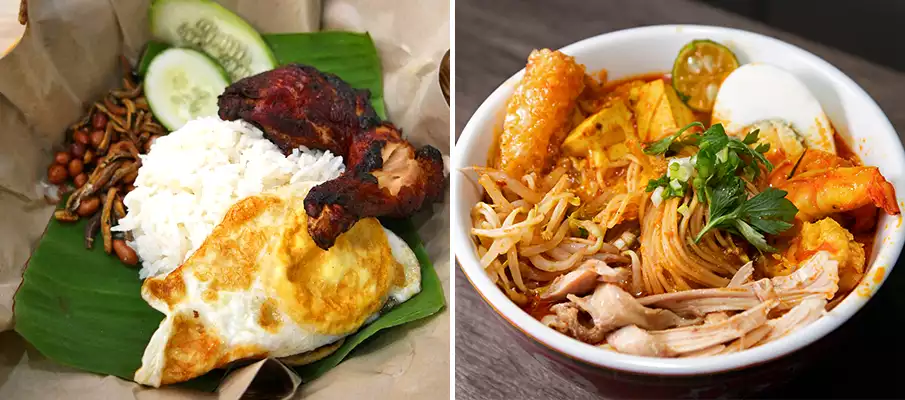
Favorite Spices / Ingredients in Malaysian Cuisine:
Malaysian cuisine entices its visitors not only with the richness of exotic dishes but also with the unique combination of spices and ingredients. These elements create a harmony of flavors that are characteristic of the region, providing authentic Malaysian identity to the dishes. Here are five favorite spices and five ingredients that play a crucial role in this culinary symphony.
Favorite Spices in Malaysia:
-
- Turmeric (Kunyit): Turmeric imparts a golden color and a slightly bitter taste to dishes. It is often used in curries and possesses medicinal properties.
- Coriander (Ketumbar): Coriander adds a refreshing citrus taste and aroma to many dishes. Both seeds and leaves are popular, whether in curries or salads.
- Cinnamon (Kayu Manis): Cinnamon brings a sweet and aromatic note to meals. It is frequently used in desserts but also in curries and beverages.
- Cloves (Bunga Cengkih): Cloves add a warm and spicy flavor to food. They are essential for marinades and some traditional dishes.
- Galangal (Lengkuas): This spicy plant, similar to ginger, adds a citrusy and pungent taste to dishes. It holds significance in Malaysian cuisine and is often used in curry blends.
Favorite Ingredients in Malaysia:
-
- Coconut Milk (Santan): Coconut milk is a fundamental ingredient in many Malaysian dishes, providing rich texture and sweet taste.
- Rice (Nasi): Rice is an essential part of daily meals in Malaysia. It is used in various forms, from classic steamed rice to nasi lemak.
- Limes (Limau): Limes are a crucial ingredient that adds a sour freshness to dishes. They are often used in marinades and sauces.
- Fish Sauce (Kicap Ikan): Fish sauce is a fundamental seasoning for most Malaysian dishes, imparting a salty taste and depth to sauces and soups.
- Pandan Leaves (Daun Pandan): Pandan leaves are frequently used in cooking rice and desserts, adding fragrance and a subtle sweetness.
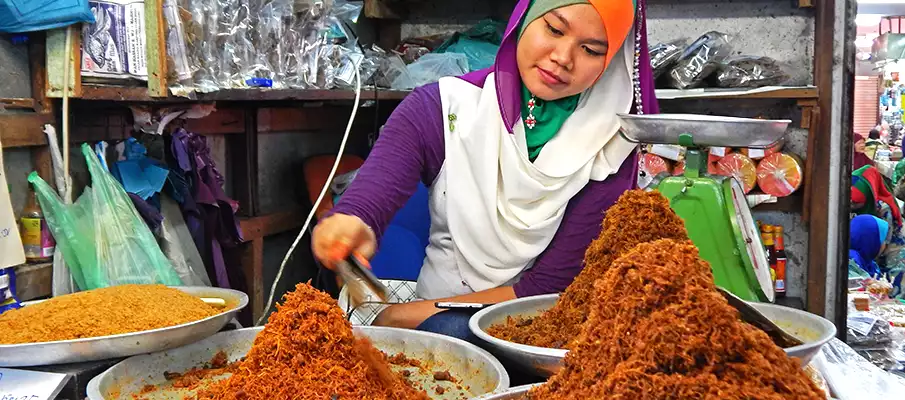
Regional Variations of Dishes and Cuisine in Malaysia:
Malaysian cuisine is not just a uniform set of dishes but rather a fascinating mosaic of regional variations, each reflecting unique cultural influences, ingredients, and traditions of a specific area. Here are some regional variations that enrich the Malaysian culinary scene:
-
- 1. Kelantan and Terengganu: These northeastern states are known for their love of fish and rice. Kelantan is home to „nasi dagang,“ a mixture of rice with fish curry and coconut milk. Meanwhile, Terengganu is famous for „nasi kerabu,“ where rice is colored with bunga telang flowers and served with herbs and fish curry.
- 2. Penang: Penang, an island renowned for its rich history and culinary scene, offers specialties such as „char kway teow,“ stir-fried noodles with seafood and sausage, and „Penang laksa,“ a spicy soup with rice noodles.
- 3. Perak: The Perak region is known for „Ipoh hor fun,“ delicate rice noodles served in chicken broth. This region is also home to the popular dessert „kai see hor fun,“ chicken noodles served with egg sauce.
- 4. Johor: In southern Malaysia, Johor is known for „nasi briyani gam,“ spiced and aromatic rice served with meat. Another favorite dish is „otak-otak,“ marinated fish or shrimp mix baked in banana leaves.
- 5. Sarawak and Sabah: The eastern states of Sarawak and Sabah on Borneo offer specific specialties such as „laksa Sarawak,“ a fine noodle soup with rice noodles and meat pieces. „Hinava“ is a traditional Sabah dish with fish, onions, and chili.
This regional diversity paints a picturesque image of Malaysian cuisine. Each region brings its own delicious variations, reflecting local ingredients, traditions, and taste preferences. Exploring Malaysia allows you to traverse the various culinary worlds that this country has to offer.
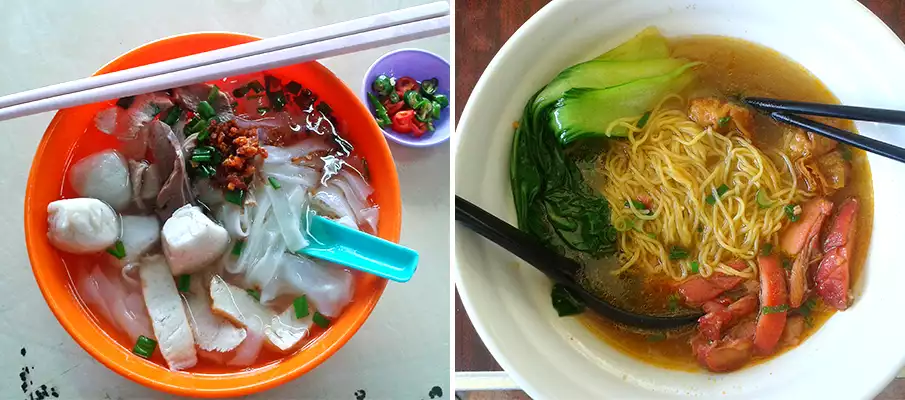
Food and Dishes in Malaysia as a Social Event:
Malaysian cuisine not only satisfies taste buds but also serves as a social magnet, bringing people together during family celebrations, festivals, and everyday gatherings. Food in Malaysia is more than just sustenance—it is a cultural ritual reflecting the traditions, history, and hospitality of this rich country.
-
- Ritual of Diversity: In a country where Malay, Chinese, Indian, and ethnic cultures converge, food becomes a stage for sharing and celebrating cultural diversity. During festivals like Hari Raya, Chinese New Year, and Diwali, families and friends gather around lavishly set tables, blending various flavors and aromas.
- Nasi Lemak and Family Connection: Dishes like „nasi lemak,“ considered a national treasure, are often associated with family breakfasts or festive lunches. Similar to the diversity of ingredients in nasi lemak, family groups unite their traditions and histories, sharing food as part of their heritage.
- Street Food as a Cultural Catalyst: Street food markets in Malaysian cities become lively spaces for meeting and communication. Here, people of different ethnicities and classes share tables, taste various delicacies, and discuss current events. Street food becomes a place where life stories intertwine, forever linking dining experiences with community spirit.
- Nasi Campur and Refreshing Diversity: „Nasi campur,“ meaning mixed rice, is an example of how diversity can bring people together. This dish contains small portions of various foods, from curry to grilled fish. It reflects the cosmopolitan character of Malaysia, where different flavors meet and mingle on one plate.
- Festivals or Various Celebrations: Not only during formal occasions but also in everyday life, food in Malaysia is associated with joy and hospitality. Celebrations are accompanied by rich feasts, whether it’s weddings, birthdays, or simple gatherings with friends. Food becomes a means of sharing joy and creating shared memories.
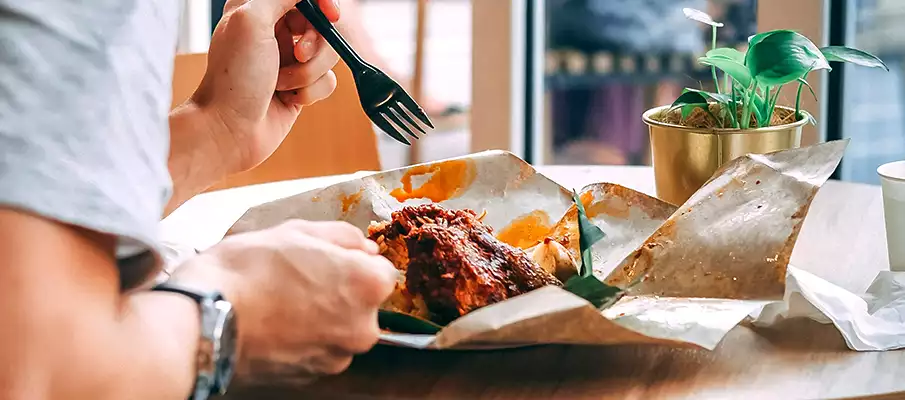
Favorite Fruits and Vegetables in Malaysia:
Malaysia, with its rich tropical climate and fertile soil, is home to a wide variety of delicious fruits and vegetables that reflect the diversity of the country’s natural wealth. Fruits and vegetables are not just part of the diet but also represent cultural heritage and are an essential component of many traditional Malaysian dishes.
Favorite Fruits in Malaysia:
-
- Durian – King of Fruits: Known as the „king of fruits,“ this fruit is renowned for its strong aroma and controversial yet distinctive creamy, custard-like texture. Despite its divisive scent, it enjoys enormous popularity.
- Mangosteen – Queen of Fruits: Dubbed the „queen of fruits,“ mangosteen is the opposite of durian with its delicately sweet, white fleshy interior and refreshing taste. It is not only a tasty treat but also packed with antioxidants.
- Rambutan – Red Hairy Jewel: Rambutan is a fruit with sweet flesh reminiscent of grapes. Its taste often features in refreshing desserts.
- Mango – King of Fruit Trees: Mango, known as the „king of fruit trees,“ is highly popular in Malaysia. There are many varieties, each with its own flavor, ranging from sweet to tangy. Mango appears in various forms, from juicy salads to curries.
- Papaya – Queen of the Tropics: Referred to as the „queen of the tropics,“ papaya is rich in vitamins C and A. It has a refreshing taste and is often consumed raw or as part of fruit salads.
Favorite Vegetables in Malaysia:
-
- Kangkung – Water Spinach: Kangkung, known as water spinach, is a popular ingredient in Asian dishes. Its tasty leaves and stems are often stir-fried with garlic and sauces.
- Bitter Melon – Bitter Melon: Bitter melon, famous for its distinctive bitterness, is favored in Malaysian cuisine. It is frequently used in soups and curries for its unique flavor.
- Cucumber – Cucumber: Cucumber is common in Malaysian dishes and salads. It is refreshing and adds a contrast to various dishes.
- Lemongrass – Lemongrass: Lemongrass is an aromatic herb often used to flavor soups and curries. It has a refreshing lemony scent.
- Turmeric – Turmeric: Turmeric, with its golden root, is widely used in Malaysia as a spice in curries and sauces. It not only provides a vibrant color but also has medicinal properties.
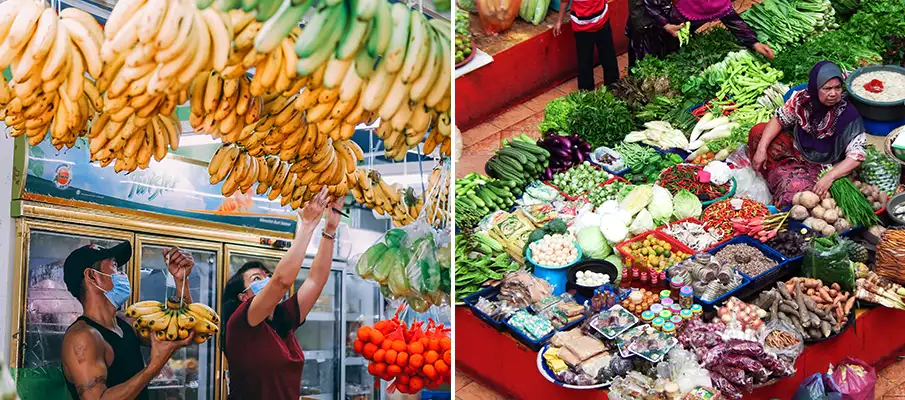
Local Beverages and Alcohol in Malaysia:
In Malaysia, a land rich in tropical fruits and exotic herbs, drinking is not just a means to cope with the hot climate but also a way to explore local flavors and traditions. Many beverages and alcoholic drinks in Malaysia reflect the cultural diversity of the country and its fascinating blend of ethnic influences.
Beverages and Drinks in Malaysia:
-
- Teh Tarik – Pulled Tea: Teh Tarik, meaning „pulled tea,“ is a popular beverage made by mixing tea with condensed milk and then pulling it between two containers. This drink is favored at street stalls as well as in cafes.
- Kopi – Malaysian Coffee: Kopi is a strong Malaysian coffee, often prepared in traditional filtering pots. Each stall may have its own recipe, providing an opportunity to explore different flavors and strength.
- Sirap Bandung – Rose Drink: Sirap Bandung is a refreshing rose drink made from rose syrup mixed with condensed milk. It’s popular in the hot climate and is often served on the streets.
- Calamansi Lime Juice – Calamansi Lime Juice: This refreshing calamansi lime juice is an ideal way to cool down in hot weather. It has a combination of sourness and subtle sweetness.
- Bandung – Rose Syrup with Milk: Bandung is another popular rose drink, this time combining rose syrup with milk. It’s a sweet and aromatic beverage often enjoyed during festive occasions.
Alcohol in Malaysia:
In Malaysia, alcohol is available but with some restrictions due to the predominantly Muslim population. Most bars and restaurants in international hotels serve alcoholic beverages. Popular alcoholic drinks include beer, wine, and some traditional spirits. However, it’s important to respect local customs and consume alcohol only in permitted areas.
Drinking in Malaysia is not just a matter of cooling down; it represents a journey of discovering local flavors and traditions. Whether indulging in traditional tea or sampling local cocktails, Malaysian beverages are an integral part of the cultural heritage of this fascinating country.
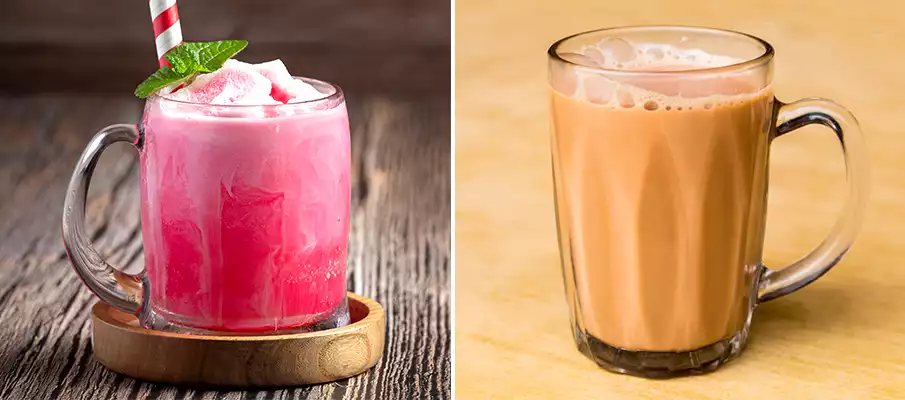
Favorite Sweet Dishes and Desserts in Malaysia:
Malaysian cuisine is rich in diverse flavors and influences, which is reflected in the realm of sweets and desserts. In this Southeast Asian country, we encounter a unique combination of exotic ingredients and traditional techniques that give rise to desserts appealing to taste buds worldwide.
-
- 1. Cendol: One of the most popular Malaysian desserts is Cendol. This refreshing treat offers flavors of coconut milk, palm sugar, green rice noodle jelly, and ice. The combination of these elements creates not only a delicious but also a refreshing dessert, perfect for Malaysia’s tropical climate.
- 2. Kuih Dadar (Pandan Crepes): Kuih Dadar, also known as Pandan Crepes, presents the Malaysian variation of the traditional pandan dessert. This pandan leaf roll filled with a mixture of coconut and palm sugar offers a combination of aromatic flavors and a delightful texture.
- 3. Pulut Tai Tai: Pulut Tai Tai is a traditional Malaysian dessert that combines sticky rice, coconut milk, and pandan leaf paste. This dessert is often presented in layers of vibrant colors, making it not only a delightful taste experience but also visually appealing.
- 4. Dodol: Dodol is a sweet and jelly-like dish popular in Malaysia during festivals and celebrations. Made from palm sugar, sticky rice, and coconut milk, this dessert offers a rich and intense flavor combined with a unique texture.
- 5. Ais Kacang: For lovers of frozen desserts, Ais Kacang is an ideal choice. This colorful dessert combines shaved ice with various toppings, such as sweetened beans, corn, nata de coco, and syrup dressing. Ais Kacang is particularly popular in Malaysia’s hot climate, bringing refreshment and joyful taste experiences.
Malaysian sweets and desserts represent an intriguing mixture of traditional and modern elements. Each piece offers a unique taste experience, reflecting the richness of Malaysian cuisine and culture. Whether you find yourself in the bustling streets of Kuala Lumpur or at village markets, you can be sure that sweets and desserts will immerse you in the world of delightful taste impressions.
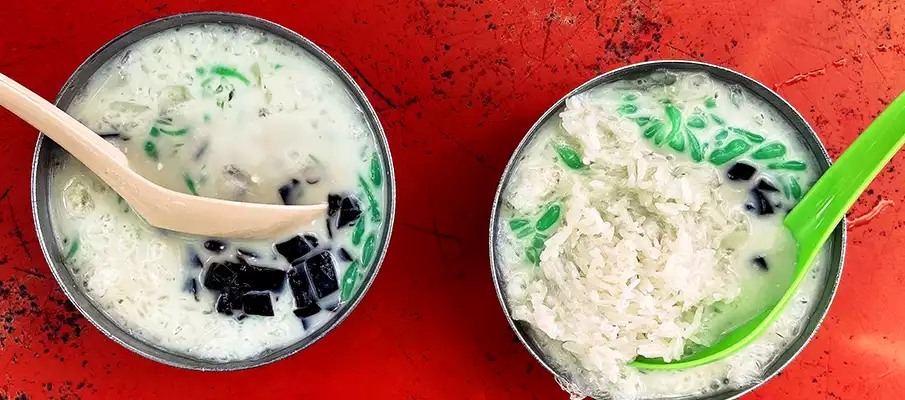
Street Food and Street Food Culture in Malaysia:
For enthusiasts of authentic taste experiences, a journey through Malaysia is not complete without immersing oneself in the fascinating world of street food. Malaysian streets pulsate with activity, aromas, and a spectrum of colors, where local chefs artistically explore different flavors and prepare dishes that not only satisfy but also enrich the culinary scene of this diverse country.
Signature Street Food Dishes:
-
- Satay – Grilled Delight: Satay, often referred to as Malaysian skewers, consists of pieces of grilled meat (usually chicken or beef) dipped in delicious peanut sauce. Street-side grills offer this popular dish.
- Nasi Goreng – Fried Rice: Nasi Goreng, meaning fried rice, is a spicy and aromatic dish prepared on large street-side pans. It includes rice, vegetables, meat, and eggs, all smothered in a delightful sauce.
- Murtabak – Stuffed Pancake: Murtabak is a thick pancake filled with a mixture of meat, onions, eggs, and spices. This dish is prepared right in front of customers, adding to its authenticity.
- Char Kway Teow – Fried Noodles: Char Kway Teow features stir-fried rice noodles with egg sauce, shrimp, sausage, and vegetables. This flavorful blend is a popular choice at street stalls.
- Rojak – Fruit and Vegetable Salad: Rojak is a refreshing mix of fruits and vegetables drizzled with spicy tamarind sauce. This contrasting combination of flavors provides a taste sensation in every bite.
Unique Flavor Combinations:
-
- Malaysian street food is not just about the food but also a comprehensive view of the culture of this country. You can witness chefs mastering their craft with passion and skill, preparing their specialties. Diverse flavors, aromatic spices, and influences from Chinese, Indian, and Malay cuisines converge on a single plate.
Street Culture as a Social Experience:
-
- Street food in Malaysia is not just about the food; it is a social event. Locals gather around stalls to share impressions and exchange tips on the best treats. Visitors have a unique opportunity to taste not only delicious dishes but also the atmosphere of friendship and joy that intertwines among the stalls.
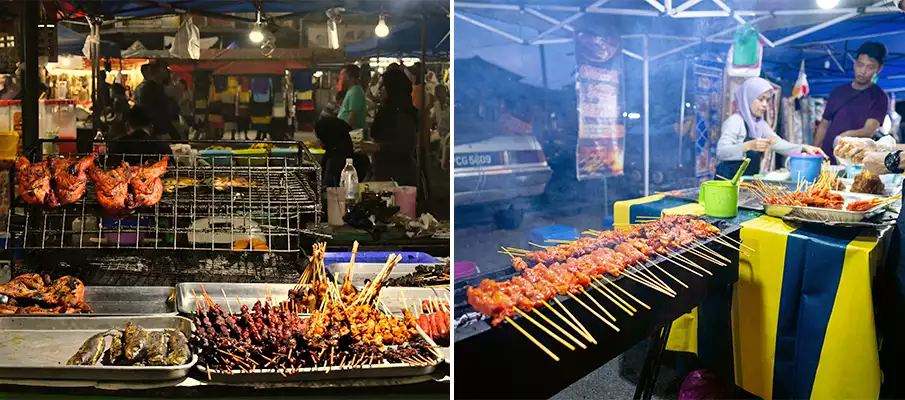
10 Favorite Dishes in Malaysia Among Tourists:
Malaysian cuisine is immensely popular among tourists due to its rich palette of flavors, exotic ingredients, and diverse culinary influences. Here are ten favorite dishes that tourists often enjoy in Malaysia:
-
- Nasi Lemak: This national dish combines aromatic cooked rice with coconut milk, roasted peanuts, smoked anchovies, banana, and spicy sambal sauce. It’s an integral part of Malaysian cuisine.
- Satay: Satay consists of skewers of marinated meat (usually chicken or beef), grilled, and served with peanut sauce. This delicacy is commonly found at street stalls and restaurants.
- Char Kway Teow: Known as Char Kway Teow, these fried noodles are full of flavor and include wide rice noodles, prawns, sausage, egg, and a sprinkle of spices.
- Laksa: Malaysian laksa is a rich, spicy soup with rice or egg noodles, coconut milk, and various ingredients such as shrimp, chicken, and herbs.
- Roti Canai: Roti Canai is a thin and crispy flatbread served with curry sauce or sweet flavors. It’s favored for its versatility and delightful taste experience.
- Hainanese Chicken Rice: This dish features boiled chicken served with fragrant rice and chili sauce. The simplicity of this dish is balanced by its excellent aroma and flavor.
- Rendang: Rendang is finely spiced meat, usually beef, cooked in coconut milk and a spice blend until it reaches a thick and aromatic consistency.
- Nasi Goreng: Nasi Goreng, or fried rice, is a spicy dish where fried rice is combined with pieces of meat, vegetables, and eggs, typically flavored with ketchup or curry sauce.
- Mee Goreng: This fried noodle mix includes rice or wheat noodles, stir-fried with curry, vegetables, eggs, and meat, creating a harmony of flavors.
- Cendol: For refreshment, Cendol is a sweet dessert containing green rice flour noodles, ice shavings, coconut milk, and sweet palm sugar syrup.
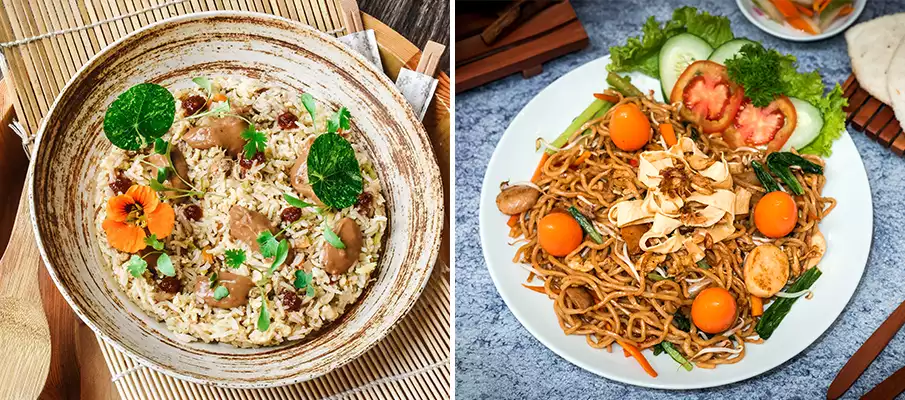
❓ FAQ + TIPS – Malaysian Cuisine, Dishes, Delicacies:
1. What characterizes Malaysian cuisine and its diverse dishes?
-
- Malaysian cuisine, with its diversity and richness of flavors, stems from the roots of Malay, Chinese, and Indian culinary traditions. Its uniqueness lies in how it artfully combines spicy, sweet, sour, and aromatic elements, creating a gastronomic experience that is unmistakably original.
2. What are the popular traditional dishes in Malaysian cuisine?
-
- Nasi Lemak, Satay, and Roti Canai are not just dishes; they are cultural icons that unveil the history and cultural diversity of Malaysia. For example, Nasi Lemak symbolizes a love for rice and a unifying force among different ethnic groups.
3. What is the significance of rice in Malaysian cuisine and dishes?
-
- Rice in Malaysian cuisine is not merely a simple side dish. It is much more – it is the foundation around which daily life revolves. Prepared in various ways, from plain boiled to fried, rice symbolizes abundance and prosperity.
4. What is the significance and influence of herbs / spices in Malaysian cuisine?
-
- Herbs and spices like lemongrass, galangal, turmeric, and coriander are not just ingredients; they are the key to unlocking the richness of flavors in Malaysian dishes. These elements not only add complexity to the food but also narrate a story of trade history and cultural blending in the region.
5. Street Food culture in Malaysia and popular street foods, what to expect?
-
- Street food in Malaysia is not just a quick way to grab a bite. It is a social gathering where people congregate around stalls to taste the best specialties of local cuisine. Char Kway Teow, Hokkien Mee, and Nasi Kerabu are not just simple dishes – they are cultural experiences.
6. What is the significance of seafood in Malaysian cuisine?
-
- Seafood is an integral part of Malaysian cuisine, which is unsurprising given the country’s coastal location. Preparing dishes like Asam Laksa or Ikan Bakar is an art – an art of capturing the flavors of the sea and connecting with the rich history of fishing.
7. What are the favorite desserts in Malaysian cuisine?
-
- Kuih, Cendol, and Durian Pancake are not just sweets; they are small artistic treasures that blend traditional recipes with regional ingredients. Each of these desserts is like a sweet fairy tale, telling of a delightful end to every meal.
8. What are the regional differences in foods in Malaysian cuisine?
9. Food markets in Malaysia, what is their influence on food choices?
-
- Markets and traditional food markets are the heart of the Malaysian culinary scene. They are not just places to buy ingredients but also for cultural exchange and gatherings. These markets are a vibrant testament to how Malaysian cuisine is intertwined with the daily lives of people.
10. What is the impact of history and migration on shaping Malaysian cuisine?
-
- The history of Malaysia, marked by migration and trade, has created a cuisine that is a symbiosis of different cultures. Indian spices, Chinese cooking techniques, and Malay flavor combinations form a unique cultural amalgam in every bite.
11. What are the social and family aspects associated with food in Malaysian culture?
-
- Food in Malaysia means not only filling the stomach but also sharing joy and building social bonds. Families gather around the table, share traditional recipes, and pass them on from generation to generation. Food is a link between the past and the present.
12. What is the role of Malaysian chefs and culinary artists?
-
- Chefs in Malaysia are not just craftsmen; they are guardians of a cultural treasure. They work to preserve traditional recipes while exploring new creative approaches to cooking. Their work is linked to the mission of passing on heritage to future generations.
13. What is the influence of modern trends on Malaysian cuisine?
-
- Gastronomic festivals and street food events are not just places to taste dishes. They are platforms to showcase traditional foods and experiment with new flavors and techniques. This interaction between traditional and modern contributes to the dynamism and vibrancy of the Malaysian culinary scene. These festivals have a significant impact on the evolution of Malaysian cuisine.
14. What is the significance of food in social and religious events in Malaysia?
-
- Food takes center stage in social celebrations and religious rituals. From wedding feasts to Ramadan meals, each event has its characteristic dishes that bring people together and create unforgettable experiences. Every grain of rice or every spoonful of spice is part of a story that intertwines through generations.
BOOK a TOUR / ACTIVITY in Malaysia ➜
| 10 Fascinating Facts About Malaysian Cuisine: | Detailed Description |
|---|---|
| 1. Multicultural Influences: | Malaysian cuisine is a captivating blend of multicultural influences, encompassing Malay, Chinese, Indian, and indigenous ethnic tribes of the country. This diversity is reflected in a wide spectrum of flavors, ingredients, and traditional cooking methods. |
| 2. Nasi Lemak – National Dish: | Nasi Lemak, coconut rice served with fish sauce, roasted peanuts, bacon, and egg, is considered Malaysia’s national dish. This simple and flavorful combination is beloved, from street stalls to high-end restaurants, gaining popularity even among international tourists. |
| 3. Street Food Culture: | Malaysia is renowned for its rich street food culture. Dishes like Char Kway Teow (stir-fried wide rice noodles), Satay (grilled meat skewers), and Roti Canai (flatbread served with sauces) are widely available, providing an authentic snapshot of local cuisine. |
| 4. Diversity of Flavors and Aromas: | Malaysian cuisine stands out with its diversity of flavors and aromas. The use of spices, herbs, coconut milk, and citrus fruits adds complex layers of taste. Some dishes are spicy, others sweet, ensuring an unforgettable experience with every meal. |
| 5. Kopi Coffee and Teh Tarik: | Kopi Coffee and Teh Tarik (pulled tea) are popular beverages in Malaysian coffee culture. Coffee is often prepared using traditional methods, and Teh Tarik is known for its art of pulling and mixing tea, creating a rich froth. |
| 6. Back to Roots – Traditional Preparation Methods: | Despite modernization, many Malaysian chefs are returning to traditional methods of food preparation. Some restaurants and stalls still use wood fires to achieve an authentic charcoal aroma, typical of traditional grilling and frying. |
| 7. Durian – King of Fruits: | Durian, known as the „king of fruits,“ is a controversial fruit with an intense aroma. Despite being banned in some hotels and public transport due to its smell, durian enthusiasts enjoy it for its creamy texture and rich flavor. |
| 8. Festivals and Food: | Malaysian festivals and celebrations are associated with rich food and traditional dishes. During Ramadan, street stalls are filled with various desserts, while Chinese New Year celebrations feature traditional dishes like Yee Sang (a mix of raw fish and vegetables). |
| 9. Peranakan Cuisine: | Peranakan cuisine, also known as Nyonya or Straits Chinese cuisine, blends Chinese, Malay, and Indian influences. Traditional dishes like Laksa (noodle soup with curry sauce) and Ayam Pongteh (chicken cooked in soy sauce) reflect this unique cultural fusion. |
| 10. Culinary Tourism Experiences: | The rise of culinary tourism allows visitors to explore the secrets of Malaysian cuisine. Besides tasting local specialties, travelers can visit markets, attend cooking classes, and dine in restaurants to deepen their knowledge and understanding of the richness of Malaysian gastronomy. |
Money + Currency in Thailand|Money + Currency in Laos|Money + Currency in Cambodia|Prices in Thailand|Prices in Laos|Prices in Cambodia




